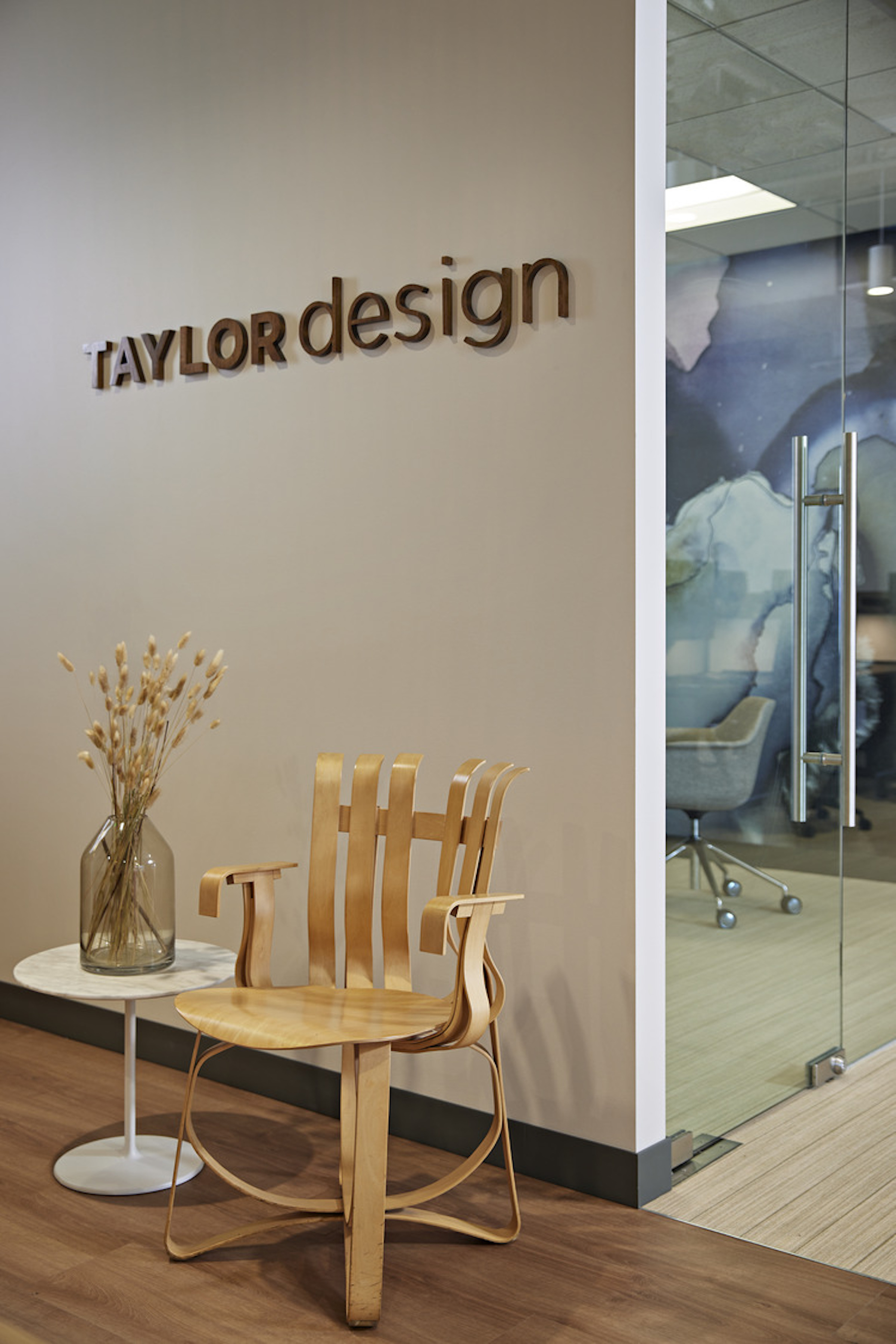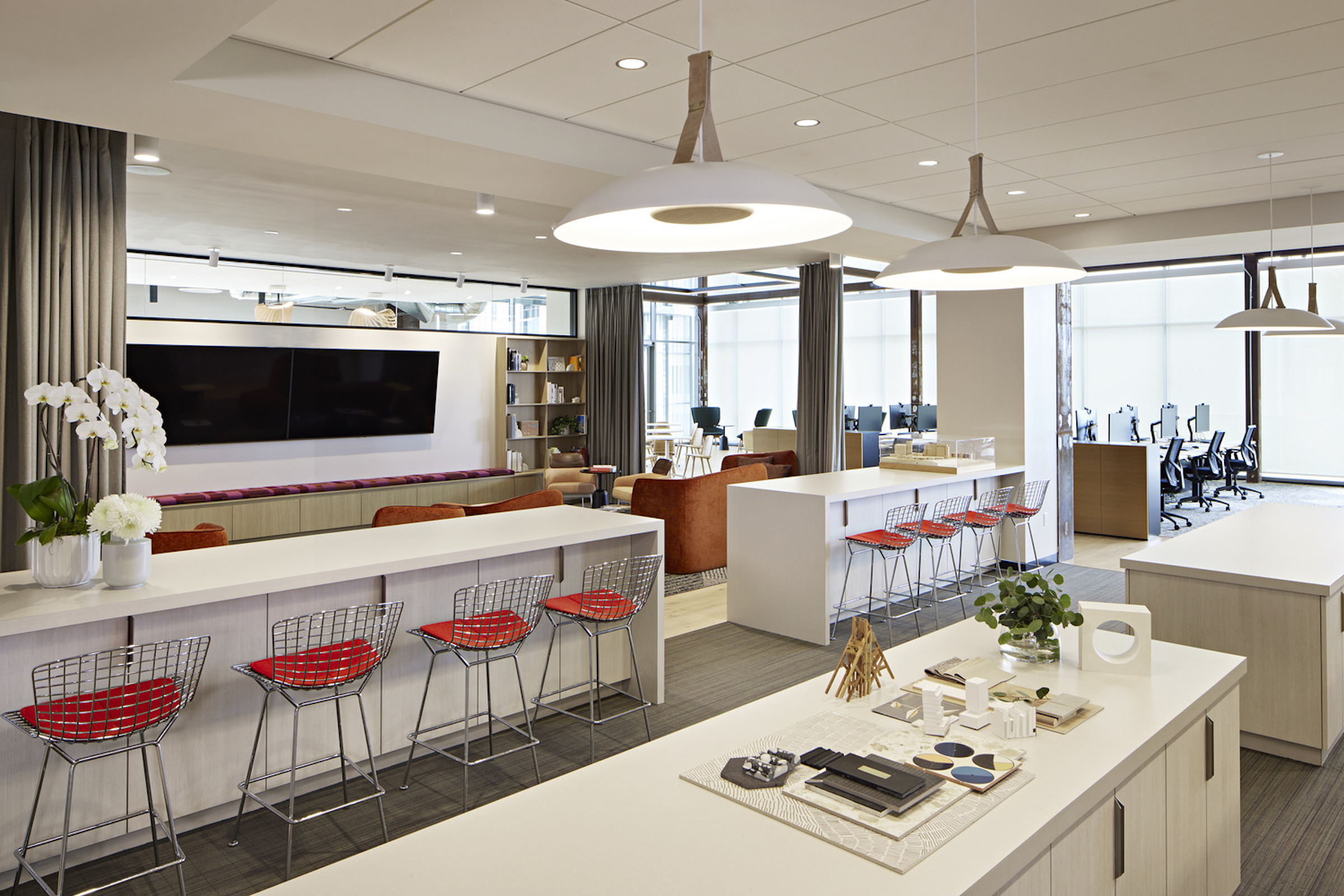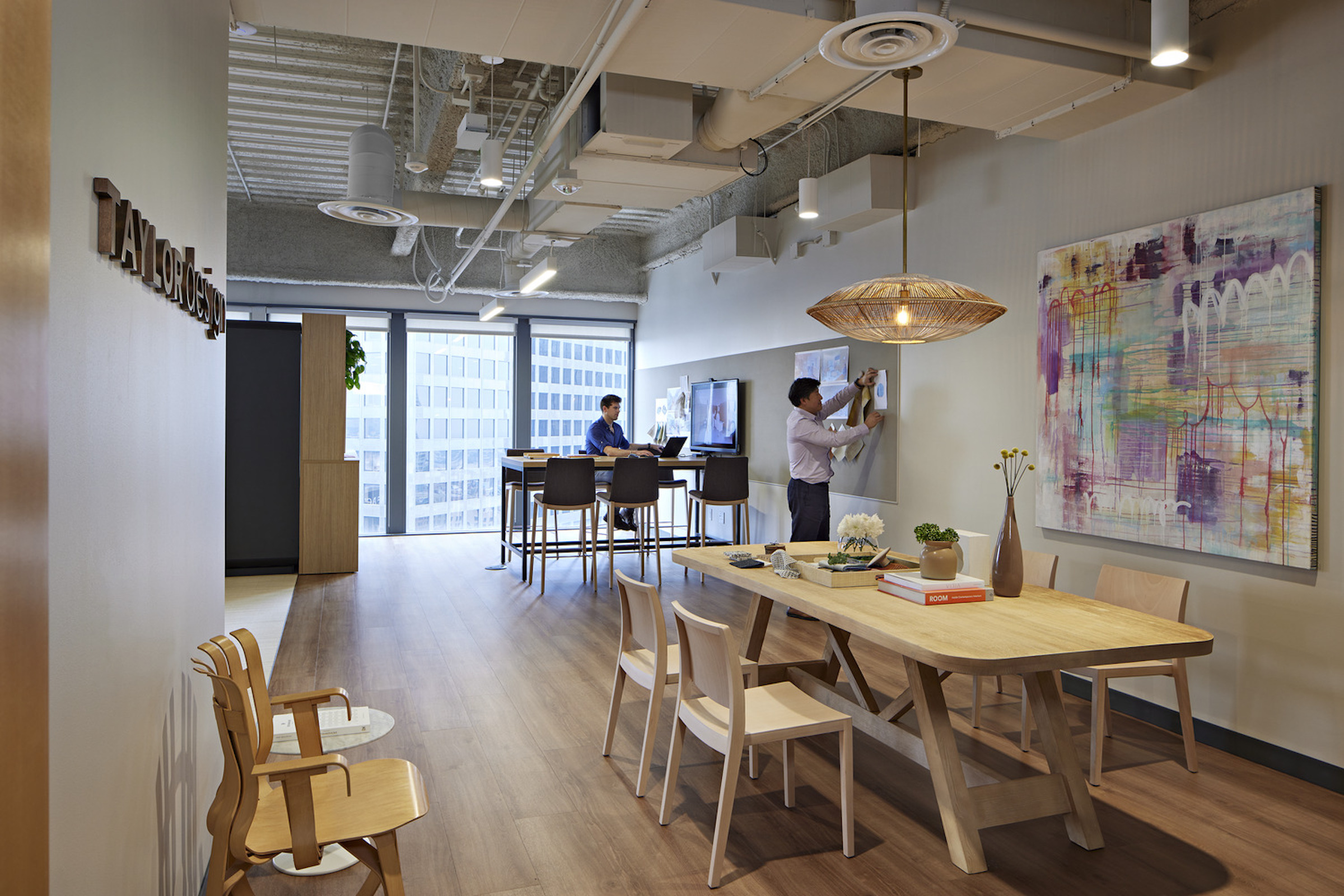Companies create design standards for many reasons, including brand recognition and to simplify the procurement process. These standards provide explicit direction for the way the company uses art, lighting, space layouts, furniture, fabrics, security, technology and many other components of the design process.
Design standards can serve another purpose — to help the design team understand how much of the project must “stay within the lines” and how much is subject to creative interpretation. Because this ratio is often about 70%-30%, we use the term “Find Your 30” at Taylor Design.
This is an approximation, of course. We settled on “Find Your 30,” but every organization carries different standards, priorities and brand-driven requirements into a design project. For some companies, the ratio is 90%-10%; for others it may be closer to 50%-50%. When we designed our new Sacramento, Los Angeles and Orange County offices, we ensured that our breakdown was 70%-30%.
What does “Find Your 30” mean?
It is as important to identify your ideal ratio as it is to decide to create design standards in the first place. This informs the designer exactly how much freedom they have to use their skill and creativity to celebrate a unique culture from location to location.
Finding Your 30 gives each office a sense of autonomy, and it allows for bigger and broader concepts that emphasize distinctive cultural, historic or other similar attributes. While the “70” holds true to the company’s requirements for branding, company colors, furniture and materials, the “30” affords the designer – in collaboration with the owner and their team – the opportunity to deviate from the standards and introduce artwork, fittings, color accents and other elements that communicate a sense of community and ownership. This freer expression is often used to highlight cultural and historic aspects of the physical location, but can also reference other qualities, such as the firm’s mission, history, signature work or founding partners.
Why is this important?
When a design team goes into a project fully aware of what is flexible and what is not, it saves time, which saves money. Also, when you fail to define the ratio – to Find Your 30 – you lose an opportunity to simultaneously illustrate brand consistency with a uniqueness of place. This is particularly true in a renovation setting, where the goal is to seamlessly marry existing finishes with newly created standards in a complementary way. This lack of direction can lead to decisions being made on the fly, often badly. It invites confusion, crushes momentum and can cast a pall over the entire project.
The challenge and opportunity
Taylor Design approached its latest office space updates with a firm commitment to allowing each office 30% choice to promote the uniqueness of their space. Like many multiple-office firms, we encountered both lease extensions and entirely new locations, which added to the challenge. As we set about creating spaces that represent the singular Taylor Design Brand, while giving each location room to design a thoughtful story, we asked ourselves a number of questions:

What do we want clients and employees to feel and think about when they are in the space? As both designers ourselves and occupants of the space, we know that the answer lies in telling a lasting narrative about who Taylor Design is, what we stand for, and how the occupants of this particular office are firmly in the Taylor Design fold, yet also representative of the characteristics of the locality. The “30” helps to define the entire experience.
What standards should we employ? Standards in this context offer two parallel benefits: they help accentuate the brand (e.g., values, mission) and illustrate the culture (e.g., what makes us different). The goal is to craft a meaningful story within our spaces that keeps our mission front and center — “Design that Empowers People” — while sharing who we are as a distinctive community of designers.
Should we concentrate the “30” in a single part of the office or spread it throughout? In some cases, but especially when the ratio is 90%-10%, the creative component is limited to one space – often the lobby. We decided quickly that we wanted to weave our 30% throughout the space. One of the ways we decided to represent the uniqueness of place within the context of Taylor Design was to ask our founder, Linda Taylor, to use her remarkable artistic talent to provide paintings that are specific to each location. As a result, her artwork graces multiple locations in each office. Also, with the full 30% to work with, we had sufficient room to convey our story in multiple areas, including deep into the space to help emphasize brand identity to visitors and to our staff.
Which design elements fall in both the 70% and the 30%? The theory of “Find Your 30” doesn’t require every design component to fall within one camp or the other; it can sometimes be in both. For example, in our office renovations, employees shared their personal inspirations with Linda Taylor to help stimulate the original artwork of each location. Commissioning Linda to contribute paintings falls in the 70% standard – each office will have a piece of her art. However, because each piece reflects the unique inspiration of the employees in the office, it also falls within the 30%. The same holds true for engaging with local community artists. Each office location worked with and commissioned an original piece of art from a community artist. As with our founder’s art, the community artist’s work is part of both the 70% and the 30%.

How should we get where we want to be? We held workshops featuring exercises that helped define the challenge of each space and seek solutions within the framework of Find Your 30. We used 70%-30% as an aid to determine whether a challenge or solution belonged to the rigid design standards of the former, or the freedom of expression in the latter. For example, we specified material, including natural grass and a graphic wallcovering, explicitly to illustrate to our clients’ how to introduce biophilia in sophisticated ways.
At the heart of it, Find Your 30 is about the experience of a place. Experience is defined by the culture – it’s the feeling you carry with you after you leave. It is the layering of information and how it eventually comes together as a cohesive story. It is about the things that make a space memorable. So when a design team adapts design standards appropriately and insightfully, within the context of the 70%-30% rule, the result is a space that supports and enhances your organization’s message, mission and values.
About the Author
Stephanie L’Estrange is Principal/Director of Interior Design for Taylor Design, a multidiscipline design firm with five offices in California.
Related Stories
| Aug 11, 2010
Office complex will incorporate a bit of Summit, N.J., history
Greenock Capital Management and CB Richard Ellis have broken ground on the 46,570-sf Claremont Corporate Center in Summit, N.J. The two-story, Class A office complex will incorporate the adjacent turn-of-the-century Risk Mansion, family home of Dr. William H. Risk, who settled in Summit in 1873. The mansion will be the focus of the facility, with new, modern offices and below-grade parking cons...
| Aug 11, 2010
RMJM unveils design details for $1B green development in Turkey
RMJM has unveiled the design for the $1 billion Varyap Meridian development it is master planning in Istanbul, Turkey's Atasehir district, a new residential and business district. Set on a highly visible site that features panoramic views stretching from the Bosporus Strait in the west to the Sea of Marmara to the south, the 372,000-square-meter development includes a 60-story tower, 1,500 resi...
| Aug 11, 2010
LEED Platinum office complex opens in Morristown
The new headquarters for the Geraldine R. Dodge Foundation in Morristown, N.J., is on track to achieve LEED Platinum certification from the U.S. Green Building Council. Designed by Minno & Wasko Architects and Planners, Lambertville, N.J., the $9.5 million building includes four floors of office space and an adjacent 791-space parking deck.
| Aug 11, 2010
'Feebate' program to reward green buildings in Portland, Ore.
Officials in Portland, Ore., have proposed a green building incentive program that would be the first of its kind in the U.S. Under the program, new commercial buildings, 20,000 sf or larger, that meet Oregon's state building code would be assessed a fee by the city of up to $3.46/sf. The fee would be waived for buildings that achieve LEED Silver certification from the U.
| Aug 11, 2010
Goettsch Partners wins design competition for Soochow Securities HQ in China
Chicago-based Goettsch Partners has been selected to design the Soochow Securities Headquarters, the new office and stock exchange building for Soochow Securities Co. Ltd. The 21-story, 441,300-sf project includes 344,400 sf of office space, an 86,100-sf stock exchange, classrooms, and underground parking.
| Aug 11, 2010
Green HQ going up in Miami
Formgroup, Coral Gables, Fla., has been commissioned by communications company CIMA Telecom to design its 24,000-sf headquarters in Miami. The nine-story, LEED Gold pre-certified office building will get 25% of its power from solar panels and will minimize energy usage with the help of automated window shades and occupancy sensors.
| Aug 11, 2010
Manhattan's Pier 57 to be transformed into $210 million cultural center
LOT-EK, Beyer Blinder Belle, and West 8 have been selected as the design team for Hudson River Park's $210 million Pier 57 redevelopment, headed by local developer Young Woo & Associates. The 375,000-sf vacant passenger ship terminal will be transformed into a cultural center, small business incubator, and public park, including a rooftop venue for the Tribeca Film Festival.
| Aug 11, 2010
Manhattan's latest boutique hotel will be LEED Silver certified
New York-based developer Tribeca Associates has commissioned Brennan Beer Gorman Architects to design its latest mixed-use office and boutique hotel at 330 Hudson Street. Located in the downtown Hudson Square area of Manhattan, the LEED-Silver development will involve the redevelopment of a historic, eight-story warehouse building into 292,000 sf of office space, 15,000 sf of retail space, and ...
| Aug 11, 2010
NASA plans federal government's greenest building
NASA is set to break ground on what the agency expects to be the highest-performing building in the federal government's portfolio. Named Sustainability Base, the building at Ames Research Center in Sunnyvale, Calif., will be a showplace for sustainable technologies, featuring some of the agency's most advanced recycling and intelligent controls technologies originally developed to support NASA...
| Aug 11, 2010
U.S. firm designing massive Taiwan project
MulvannyG2 Architecture is designing one of Taipei, Taiwan's largest urban redevelopment projects. The Bellevue, Wash., firm is working with developer The Global Team Group to create Aquapearl, a mixed-use complex that's part of the Taipei government's "Good Looking Taipei 2010" initiative to spur redevelopment of the city's Songjian District.







